Degradation Measurement and Modelling under Ageing in a 16 nm FinFET FPGA
Abstract
:1. Introduction
1.1. Context
1.2. State-of-the-Art FinFET Ageing
1.3. Are Predictions of Transistor Reliability under Ageing Based on a Few Hours of Measurements Realistic?
- A test board dedicated to measuring transistor degradation;
- Probes, sometimes nanometric, depending on the dimensions of the transistor being measured;
- Specific instrumentation to place the probes and measure the threshold voltage.
1.4. Measuring Degradation in an FPGA
1.5. Purpose of the Article and Plan
- Before ageing, we compare the propagation times measured with those estimated by the design software (Vivado ML 2023.2);
- After 8000 h of ageing, we present the degradations measured in 5103 ring oscillators split between nine FPGAs with temperatures between 25 °C and 115 °C and voltages from to 1.3 ;
- We compare our degradation results with studies carried out on 28 nm MOSFET FPGAs to relate the evolution of reliability from MOSFET to FinFET;
- We present a new method to separate degradations in logic and routing resources in the FPGA;
- We propose a semiempirical model to predict degradation as a function of temperature, voltage, cyclic ratio and the resources used in the FPGA.
2. Presentation of the Test Bench
2.1. Methodology
2.2. Test Bench Architecture
2.3. Test Strategy
- The logical function of the LUT: inverter (L1 I), buffer (L1 B), XOR inverter (L2 XI) and XOR buffer (L2 XB);
- The number of LUT inputs used: 3 inputs (L3 XB) and 5 inputs (L5 XB);
- Which input of the LUT is used: input I1 (L3 XB I1) and input I5 (L3 XB I5).
3. Results Observation
3.1. Measures before Ageing
- Study the RO period distribution in order to extract information on our RO bench;
- Compare with performances expected by the design software Vivado;
- Validate the ability of our test bench to measure RO if the Vivado and measurement results are consistent.
3.2. Measures after Ageing
3.3. FPGA Zynq UltraScale+ 16 nm FinFET vs. FPGA Artix 28 nm HKMG
4. A Method for Extracting Degradation in Logical and Routing Resources
4.1. Extraction of Logical and Routing Resources
4.2. Initial Propagation Time Extraction
- Regression 1: With the propagation time of the 567 ROs given by Vivado (see Figure 5a);
- Regression 2: With the propagation time of the 567 ROs measured in one FPGA at and ;
- Regression 3: With the initial propagation time of the 5103 ROs measured in nine FPGAs at and .
4.3. Extraction of Propagation Time Degradation
5. Modelling Degradation
5.1. Observation and Interpretation
5.2. Modelling Logical Resources Degradations under Static Stress
5.3. Modelling Routing Resources Degradations under Static Stress
5.4. Modelling Routing and Logical Resources Degradations under Dynamic Stress
5.5. Degradation Measured vs. Vivado’s Critical Limit
6. Conclusions
Author Contributions
Funding
Data Availability Statement
Conflicts of Interest
Abbreviations
| BTI | Bias Temperature Instability |
| FPGA | Field-Programmable Gate Array |
| HCI | Hot Carrier Injection |
| LP | Long Path |
| LUT | Look-Up Table |
| PIP | Programmable Interconnect Point |
| RO | Ring Oscillator |
| SHE | Self-Heating Effect |
| SP | Short Path |
| TDDB | Time-Dependent Dielectric Breakdown |
References
- Salahuddin, S.; Ni, K.; Datta, S. The era of hyper-scaling in electronics. Nat. Electron. 2018, 1, 442–450. [Google Scholar] [CrossRef]
- Hnatek, E.R. Integrated Circuit Quality and Reliability; CRC Press: Boca Raton, FL, USA, 2018. [Google Scholar]
- Goetzberger, A.; Lopez, A.D.; Strain, R.J. On the Formation of Surface States during Stress Aging of ThermalSi-SiO2 Interfaces. J. Electrochem. Soc. 1973, 120, 90. [Google Scholar] [CrossRef]
- Fair, R.; Sun, R. Threshold-voltage instability in MOSFET’s due to channel hot-hole emission. IEEE Trans. Electron Devices 1981, 28, 83–94. [Google Scholar] [CrossRef]
- Lloyd, J.R. The Lucky Electron Model for TDDB in Low-k Dielectrics. IEEE Trans. Device Mater. Reliab. 2016, 16, 452–454. [Google Scholar] [CrossRef]
- Rashid, L.; Pattabiraman, K.; Gopalakrishnan, S. Characterizing the Impact of Intermittent Hardware Faults on Programs. IEEE Trans. Reliab. 2015, 64, 297–310. [Google Scholar] [CrossRef]
- Stathis, J.H.; Mahapatra, S.; Grasser, T. Controversial issues in negative bias temperature instability. Microelectron. Reliab. 2018, 81, 244–251. [Google Scholar] [CrossRef]
- Wu, S.Y.; Lin, C.Y.; Chiang, M.; Liaw, J.; Cheng, J.; Yang, S.; Liang, M.; Miyashita, T.; Tsai, C.; Hsu, B.; et al. A 16 nm FinFET CMOS technology for mobile SoC and computing applications. In Proceedings of the 2013 IEEE International Electron Devices Meeting, Washington, DC, USA, 9–11 December 2013; IEEE: Piscataway, NJ, USA, 2013; pp. 1–9. [Google Scholar]
- Ramey, S.; Ashutosh, A.; Auth, C.; Clifford, J.; Hattendorf, M.; Hicks, J.; James, R.; Rahman, A.; Sharma, V.; St Amour, A.; et al. Intrinsic transistor reliability improvements from 22 nm tri-gate technology. In Proceedings of the 2013 IEEE International Reliability Physics Symposium (IRPS), Monterey, CA, USA, 14–18 April 2013; IEEE: Piscataway, NJ, USA, 2013; pp. 4C.5.1–4C.5.5. [Google Scholar]
- Lee, K.T.; Kang, W.; Chung, E.A.; Kim, G.; Shim, H.; Lee, H.; Kim, H.; Choe, M.; Lee, N.I.; Patel, A.; et al. Technology scaling on high-K & metal-gate FinFET BTI reliability. In Proceedings of the 2013 IEEE International Reliability Physics Symposium (IRPS), Monterey, CA, USA, 14–18 April 2013; IEEE: Piscataway, NJ, USA, 2013; pp. 2D.1.1–2D.1.4. [Google Scholar]
- Mahmoud, M.M.; Soin, N. A comparative study of lifetime reliability of planar MOSFET and FinFET due to BTI for the 16 nm CMOS technology node based on reaction-diffusion model. Microelectron. Reliab. 2019, 97, 53–65. [Google Scholar] [CrossRef]
- Jiang, H.; Liu, X.; Xu, N.; He, Y.; Du, G.; Zhang, X. Investigation of self-heating effect on hot carrier degradation in multiple-fin SOI FinFETs. IEEE Electron Device Lett. 2015, 36, 1258–1260. [Google Scholar] [CrossRef]
- Joshi, K.; Mukhopadhyay, S.; Goel, N.; Mahapatra, S. A consistent physical framework for N and P BTI in HKMG MOSFETs. In Proceedings of the 2012 IEEE International Reliability Physics Symposium (IRPS), Anaheim, CA, USA, 15–19 April 2012; IEEE: Piscataway, NJ, USA, 2012; pp. 5A.3.1–5A.3.10. [Google Scholar]
- Hu, C.; Tam, S.C.; Hsu, F.C.; Ko, P.K.; Chan, T.Y.; Terrill, K.W. Hot-electron-induced MOSFET degradation-model, monitor, and improvement. IEEE J. Solid-State Circuits 1985, 20, 295–305. [Google Scholar]
- Reisinger, H.; Brunner, U.; Heinrigs, W.; Gustin, W.; Schlunder, C. A comparison of fast methods for measuring NBTI degradation. IEEE Trans. Device Mater. Reliab. 2007, 7, 531–539. [Google Scholar] [CrossRef]
- Sun, Z.; Wang, Z.; Wang, R.; Zhang, L.; Zhang, J.; Zhang, Z.; Song, J.; Wang, D.; Ji, Z.; Huang, R. Investigation of the Off-State Degradation in Advanced FinFET Technology—Part I: Experiments and Analysis. IEEE Trans. Electron Devices 2023, 70, 914–920. [Google Scholar] [CrossRef]
- Sun, Z.; Wang, Z.; Wang, R.; Zhang, L.; Zhang, J.; Zhang, Z.; Song, J.; Wang, D.; Ji, Z.; Huang, R. Investigation of the Off-State Degradation in Advanced FinFET Technology—Part II: Compact Aging Model and Impact on Circuits. IEEE Trans. Electron Devices 2023, 70, 921–927. [Google Scholar] [CrossRef]
- Huard, V.; Denais, M.; Perrier, F.; Revil, N.; Parthasarathy, C.; Bravaix, A.; Vincent, E. A thorough investigation of MOSFETs NBTI degradation. Microelectron. Reliab. 2005, 45, 83–98. [Google Scholar] [CrossRef]
- Varghese, D.; Saha, D.; Mahapatra, S.; Ahmed, K.; Nouri, F.; Alam, M. On the dispersive versus Arrhenius temperature activation of NBTI time evolution in plasma nitrided gate oxides: Measurements, theory, and implications. In Proceedings of the IEEE International Electron Devices Meeting, 2005, IEDM Technical Digest, Washington, DC, USA, 5–7 December 2005; IEEE: Piscataway, NJ, USA, 2005; pp. 684–687. [Google Scholar]
- Denais, M.; Parthasarathy, C.; Ribes, G.; Rey-Tauriac, Y.; Revil, N.; Bravaix, A.; Huard, V.; Perrier, F. On-the-fly characterization of NBTI in ultra-thin gate oxide PMOSFET’s. In Proceedings of the IEDM Technical Digest, IEEE International Electron Devices Meeting, San Francisco, CA, USA, 13–15 December 2004; IEEE: Piscataway, NJ, USA, 2004; pp. 109–112. [Google Scholar]
- Reisinger, H.; Blank, O.; Heinrigs, W.; Gustin, W.; Schlunder, C. A comparison of very fast to very slow components in degradation and recovery due to NBTI and bulk hole trapping to existing physical models. IEEE Trans. Device Mater. Reliab. 2007, 7, 119–129. [Google Scholar] [CrossRef]
- Mitani, Y. Influence of nitrogen in ultra-thin SiON on negative bias temperature instability under AC stress. In Proceedings of the IEDM Technical Digest, IEEE International Electron Devices Meeting, San Francisco, CA, USA, 13–15 December 2004; IEEE: Piscataway, NJ, USA, 2004; pp. 117–120. [Google Scholar]
- Stott, E.A.; Wong, J.S.; Sedcole, P.; Cheung, P.Y. Degradation in FPGAs: Measurement and modelling. In Proceedings of the 18th Annual ACM/SIGDA International Symposium on Field Programmable Gate Arrays, Monterey, CA, USA, 21–23 February 2010; pp. 229–238. [Google Scholar]
- Naouss, M.; Marc, F. Design and implementation of a low cost test bench to assess the reliability of FPGA. Microelectron. Reliab. 2015, 55, 1341–1345. [Google Scholar] [CrossRef]
- Lanzieri, L.; Martino, G.; Fey, G.; Schlarb, H.; Schmidt, T.C.; Wählisch, M. A Review of Techniques for Ageing Detection and Monitoring on Embedded Systems. arXiv 2023, arXiv:2301.06804. [Google Scholar]
- Coutet, J.; Marc, F.; Clément, J.C. Investigation of CMOS reliability in 28 nm through BTI and HCI extraction. Microelectron. Reliab. 2023, 146, 115007. [Google Scholar] [CrossRef]
- Naouss, M.; Marc, F. Modelling delay degradation due to NBTI in FPGA look-up tables. In Proceedings of the 2016 26th International Conference on Field Programmable Logic and Applications (FPL), Lausanne, Switzerland, 29 August–2 September 2016; IEEE: Piscataway, NJ, USA, 2016; pp. 1–4. [Google Scholar]
- Sobas, J.; Airimitoaie, T.B.; Marc, F. Development of a high accuracy and stability test bench for ageing measurement of 16 nm FinFETs based FPGA. Microelectron. Reliab. 2022, 138, 114698. [Google Scholar] [CrossRef]
- Grasser, T. Bias Temperature Instability for Devices and Circuits; Springer Science & Business Media: Berlin, Germany, 2013. [Google Scholar]
- Pi, T.; Crotty, P.J. FPGA Lookup Table with Transmission Gate Structure for Reliable Low-Voltage Operation. U.S. Patent 6,809,552, 26 October 2004. [Google Scholar]
- Young, S.P.; Kondapalli, V.M.; Tanikella, R.K. Six-Input Look-Up Table for Use in a Field Programmable Gate Array. U.S. Patent 7,061,271, 13 June 2006. [Google Scholar]
- Ruan, A.; Yang, J.; Wan, L.; Jie, B.; Tian, Z. Insight into a generic interconnect resource model for Xilinx Virtex and Spartan series FPGAs. IEEE Trans. Circuits Syst. II Express Briefs 2013, 60, 801–805. [Google Scholar]
- Xilinx. UG835, Vivado Design Suite Tcl Command Reference Guide. DataSheet 2019.
- Liu, L.; Kapre, N. Timing-aware routing in the RapidWright framework. In Proceedings of the 2019 29th International Conference on Field Programmable Logic and Applications (FPL), Barcelona, Spain, 8–12 September 2019; IEEE: Piscataway, NJ, USA, 2019; pp. 24–30. [Google Scholar]
- Sobas, J.; Marc, F. Aging measurement and empirical modeling of BTI on FPGA using 16 nm FinFETs for static and dynamic stresses. Microelectron. Reliab. 2023, 150, 115065. [Google Scholar] [CrossRef]
- Ashraf, R.A.; Khoshavi, N.; Alzahrani, A.; DeMara, R.F.; Kiamehr, S.; Tahoori, M.B. Area-energy tradeoffs of logic wear-leveling for BTI-induced aging. In Proceedings of the ACM International Conference on Computing Frontiers, Como, Italy, 16–19 May 2016; pp. 37–44. [Google Scholar]
- Mukhopadhyay, S.; Goel, N.; Mahapatra, S. A comparative study of NBTI and PBTI using different experimental techniques. IEEE Trans. Electron Devices 2016, 63, 4038–4045. [Google Scholar] [CrossRef]
- Ramey, S.; Prasad, C.; Agostinelli, M.; Pae, S.; Walstra, S.; Gupta, S.; Hicks, J. Frequency and recovery effects in high-k BTI degradation. In Proceedings of the 2009 IEEE International Reliability Physics Symposium, Montreal, QC, Canada, 26–30 April 2009; pp. 1023–1027. [Google Scholar] [CrossRef]
- Ramey, S.; Hicks, J.; Liyanage, L.; Novak, S. BTI recovery in 22 nm tri-gate technology. In Proceedings of the 2014 IEEE International Reliability Physics Symposium, Waikoloa, HI, USA, 1–5 June 2014; IEEE: Piscataway, NJ, USA, 2014; p. XT-2. [Google Scholar]

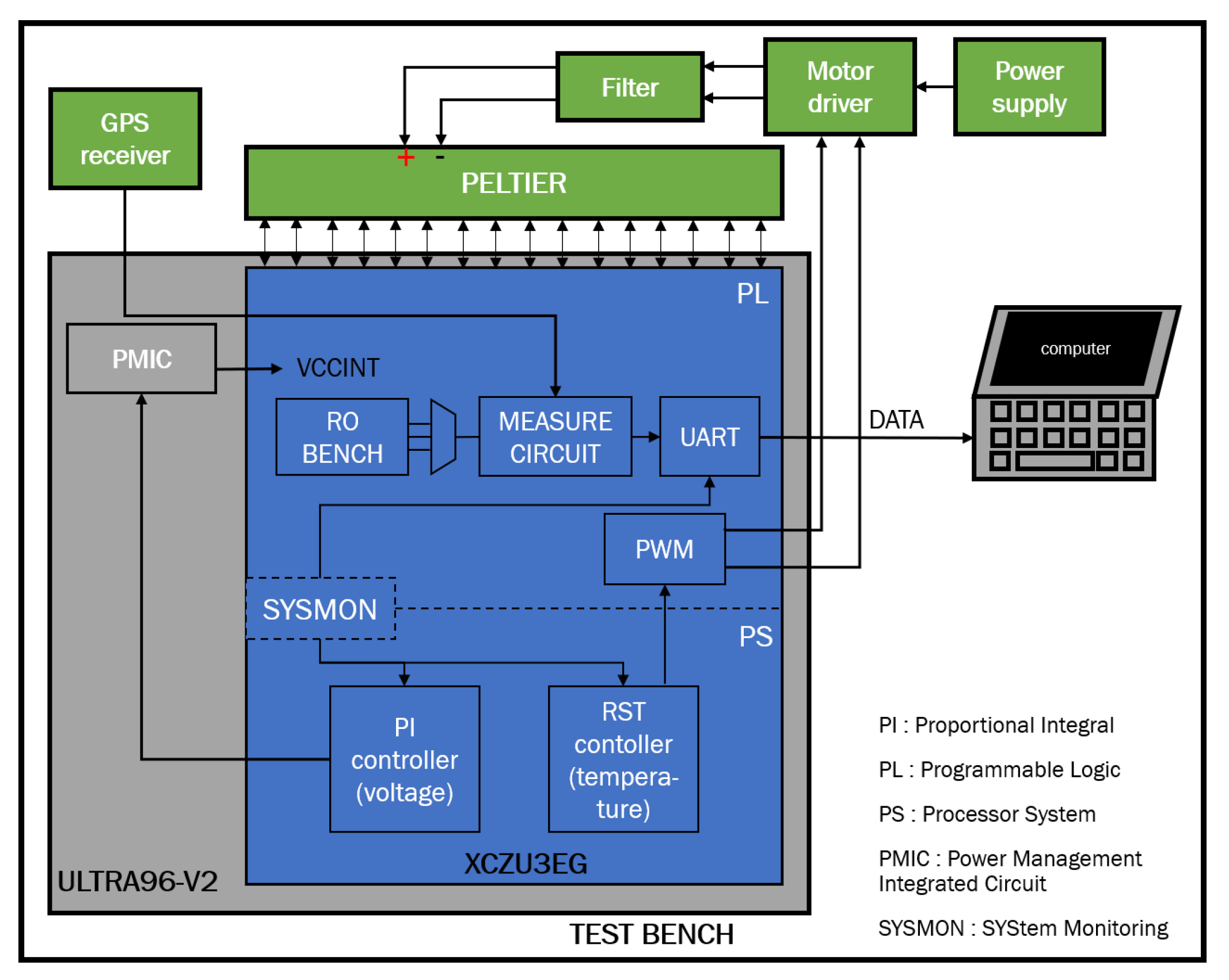
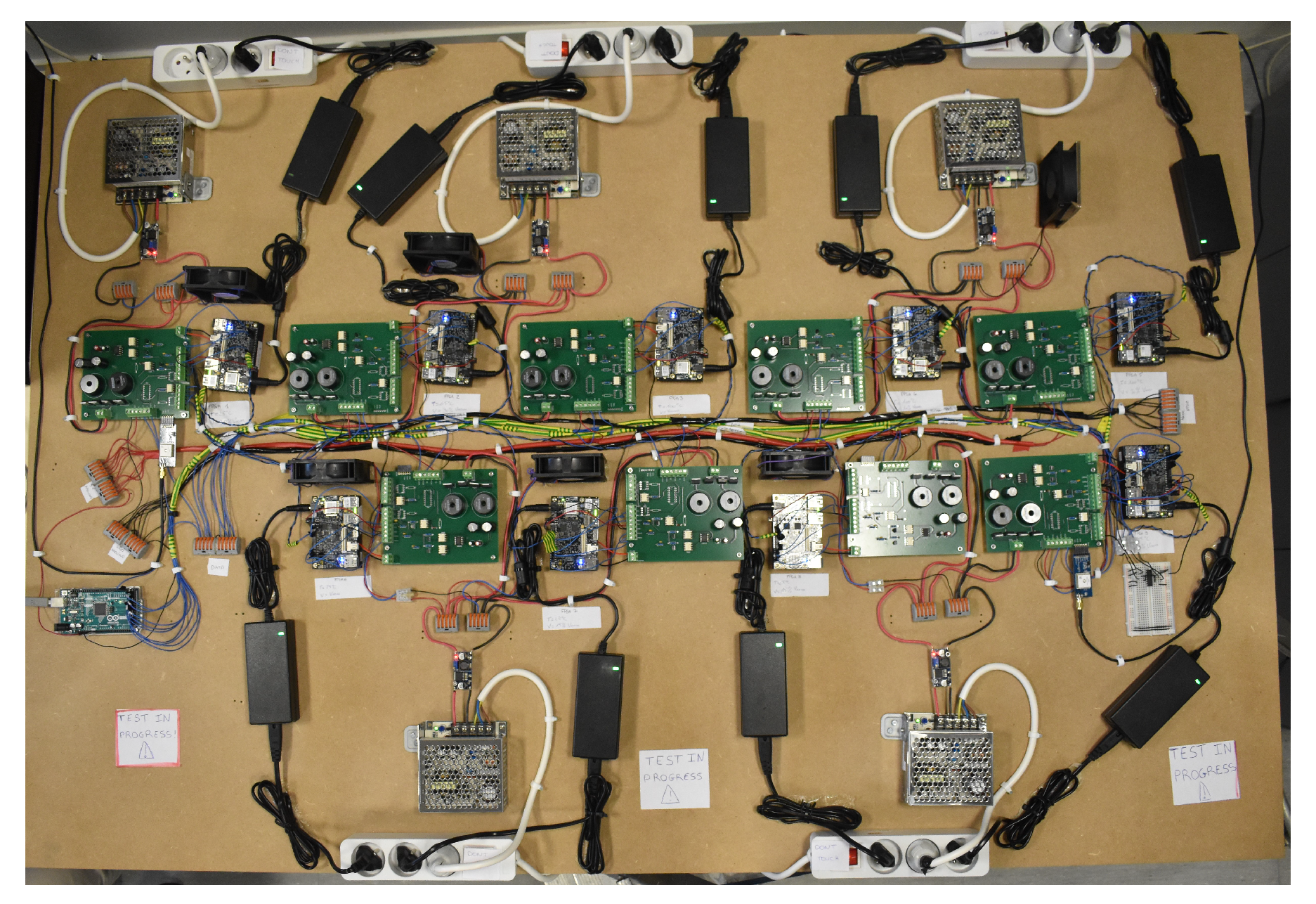
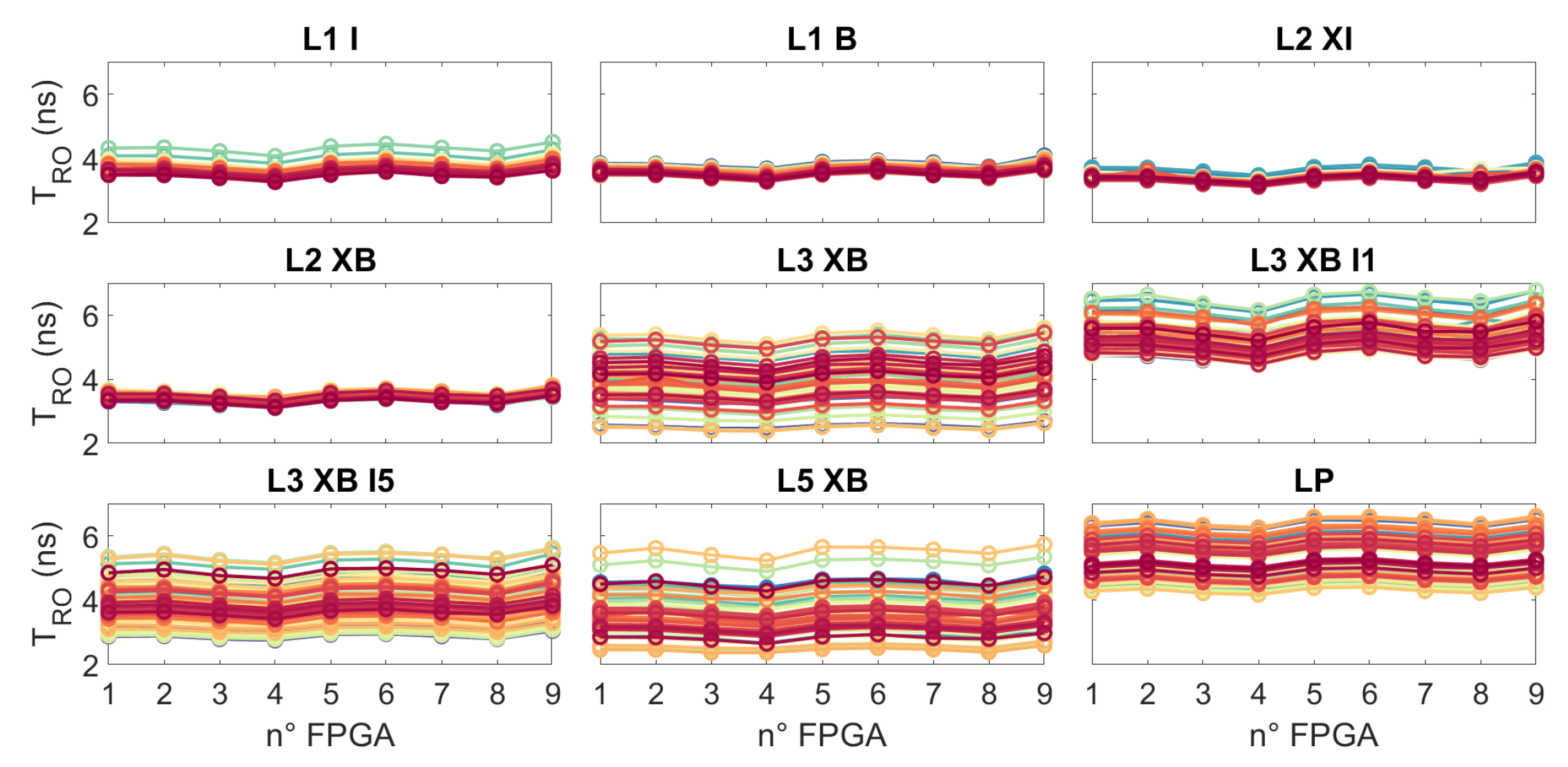
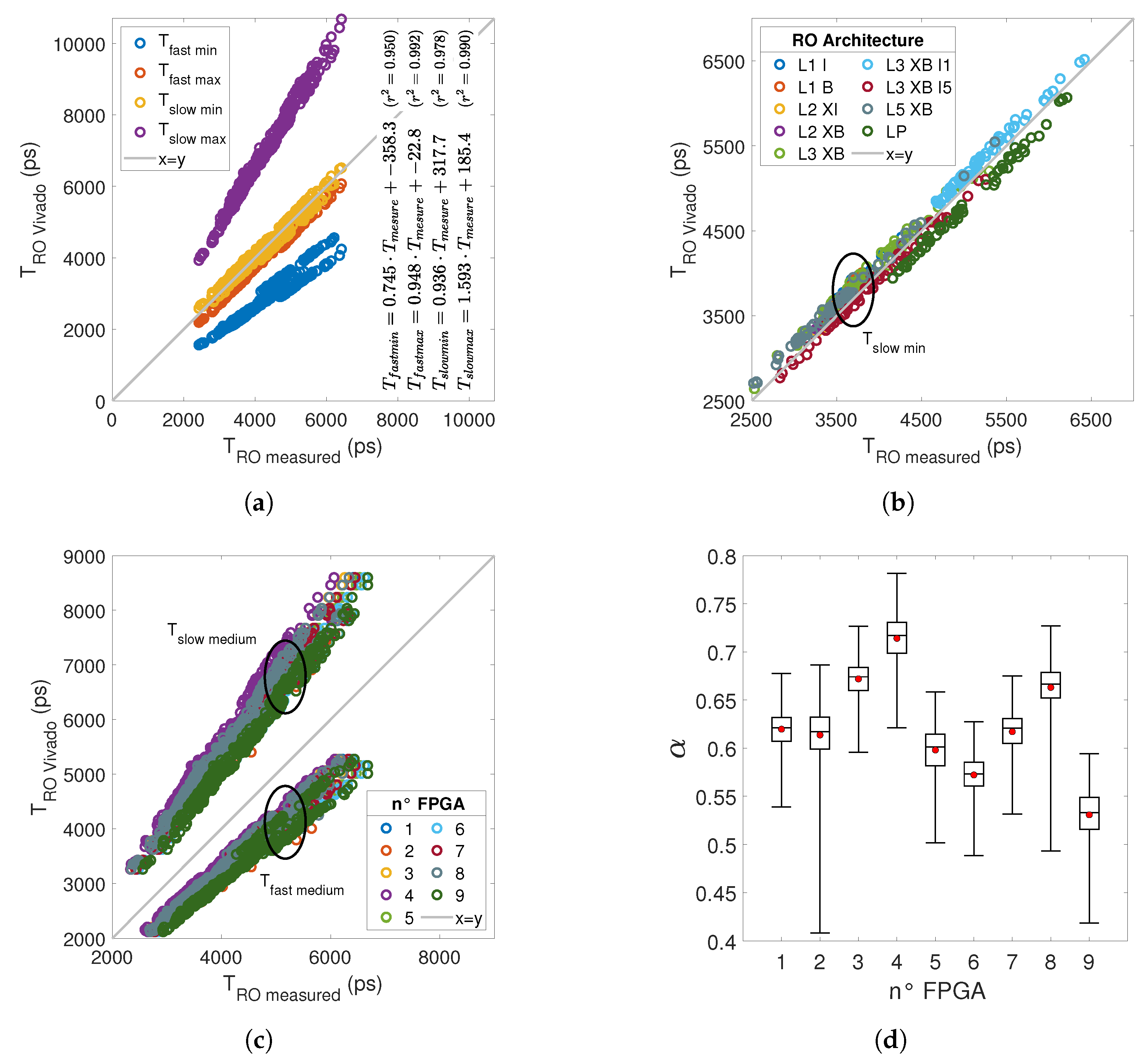
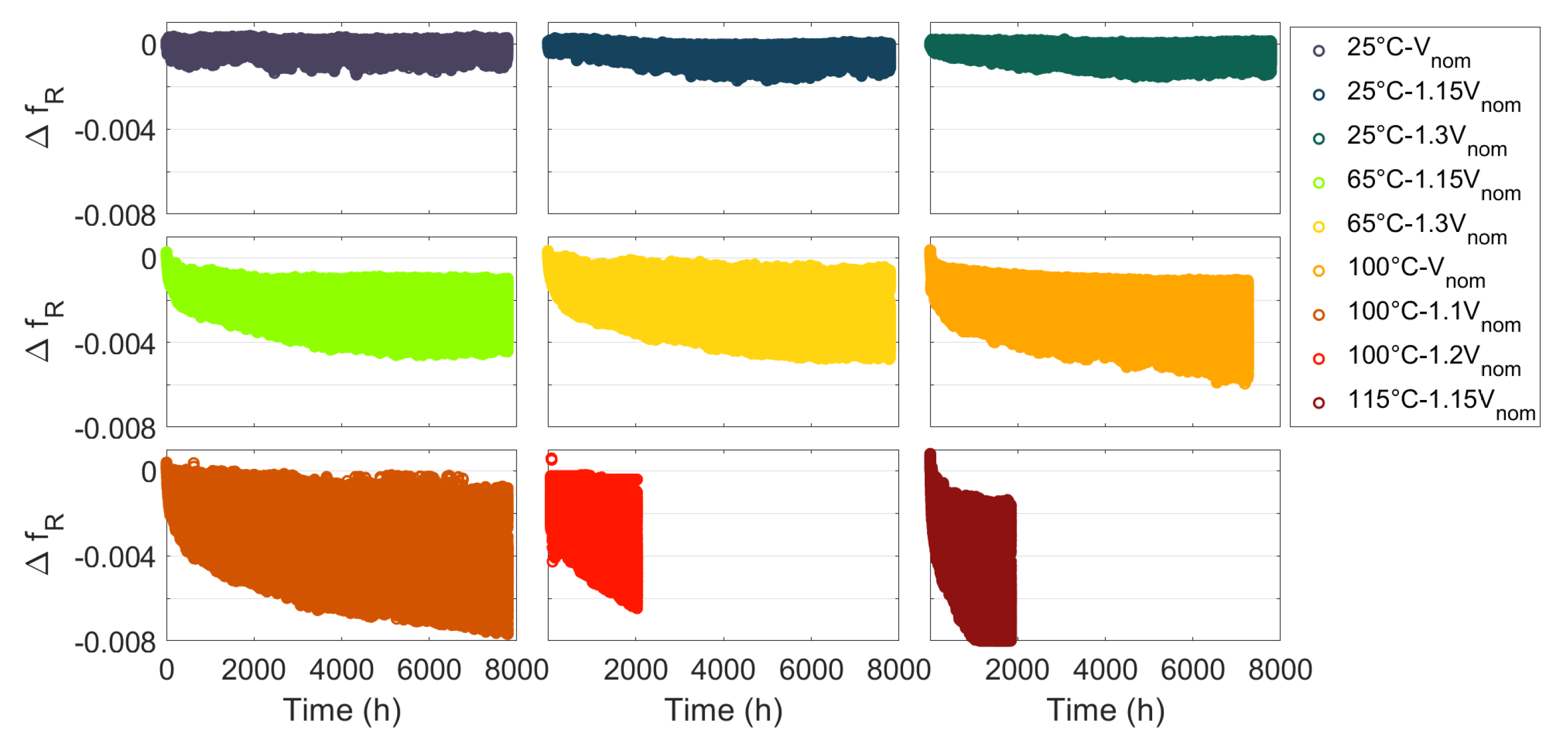
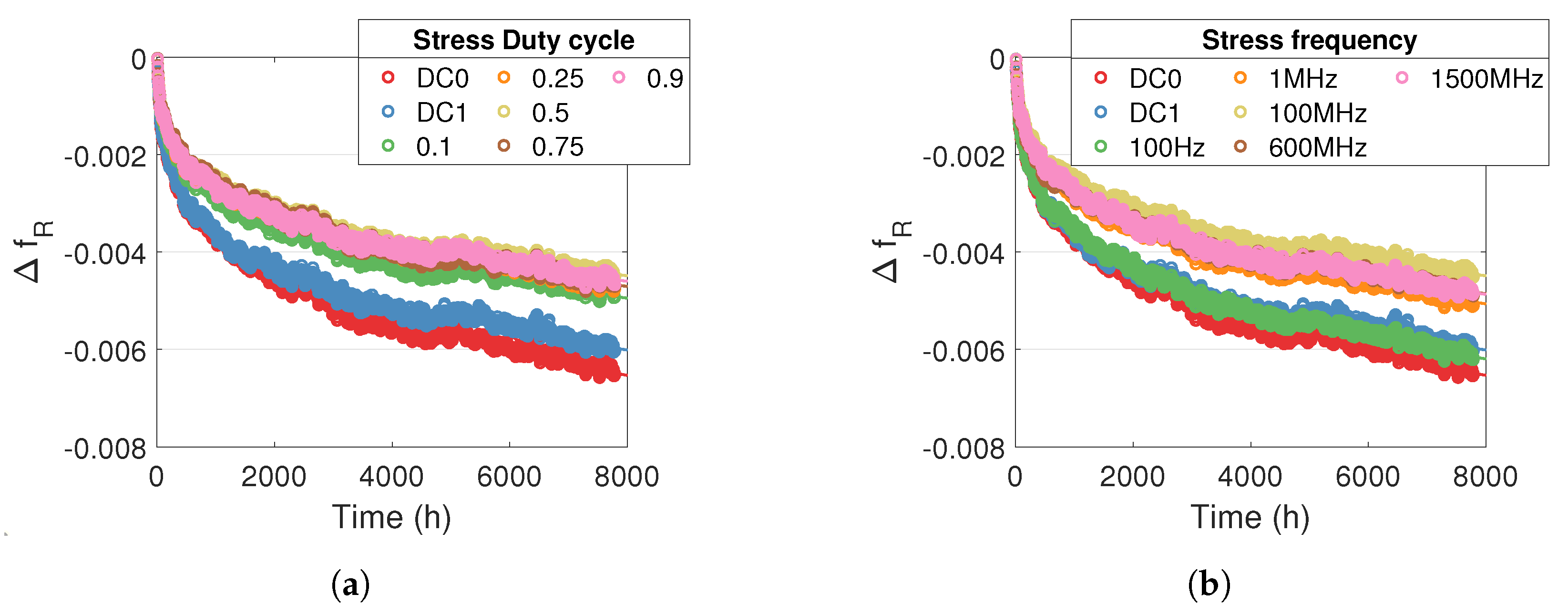
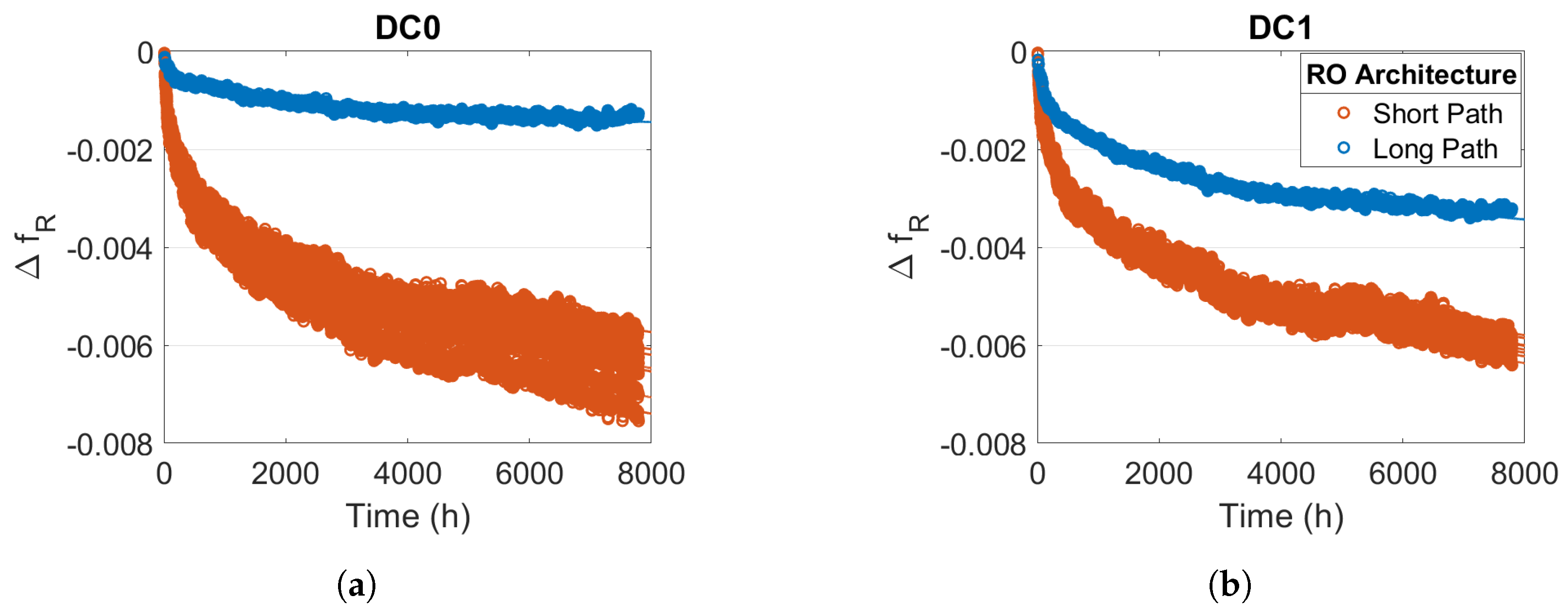

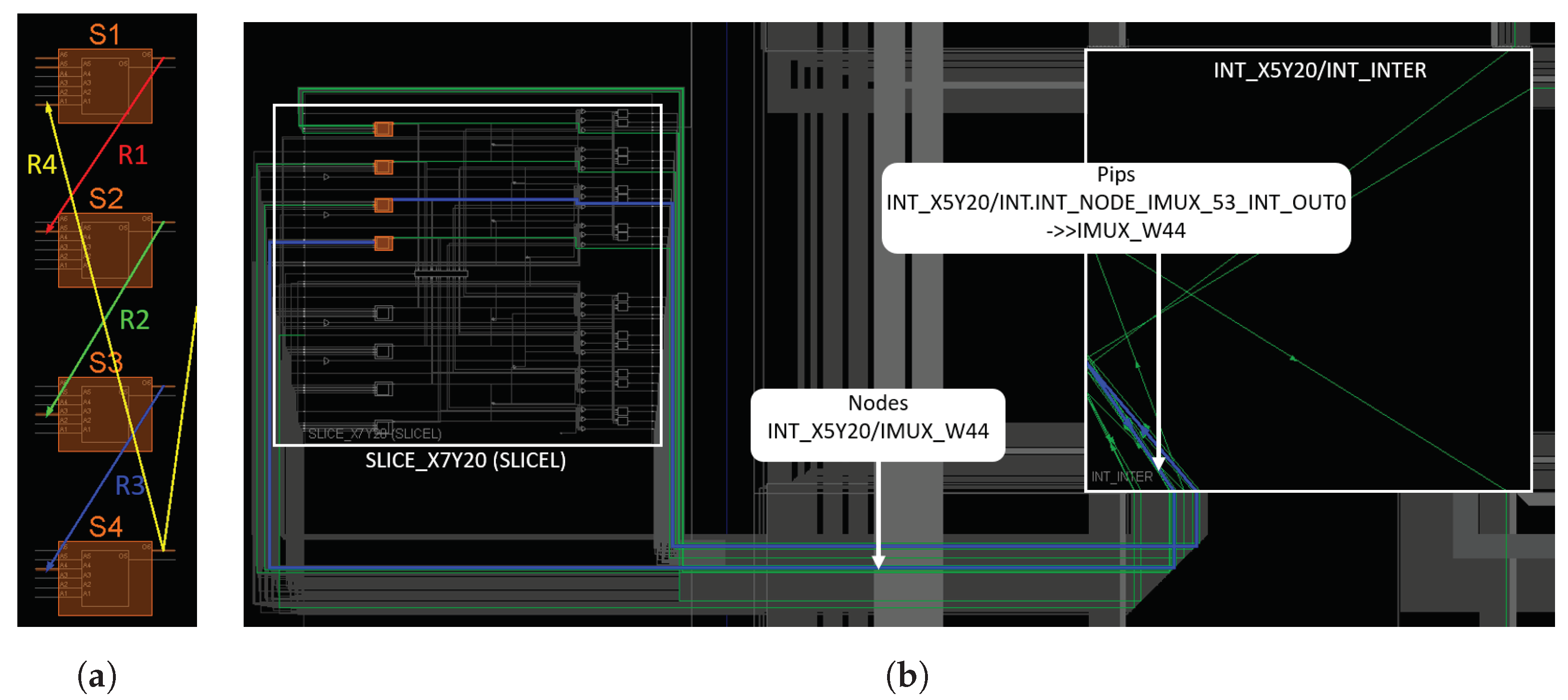
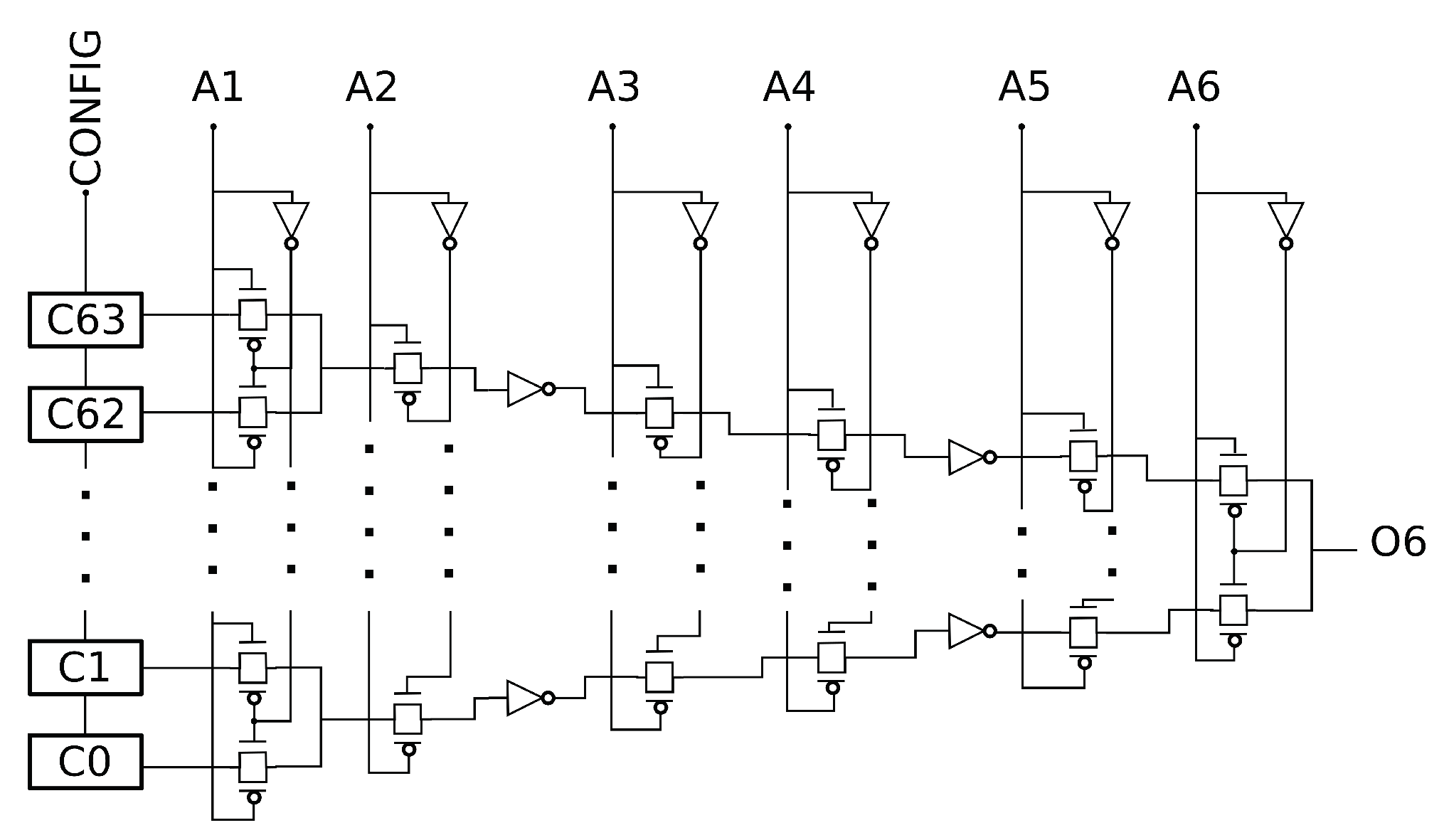


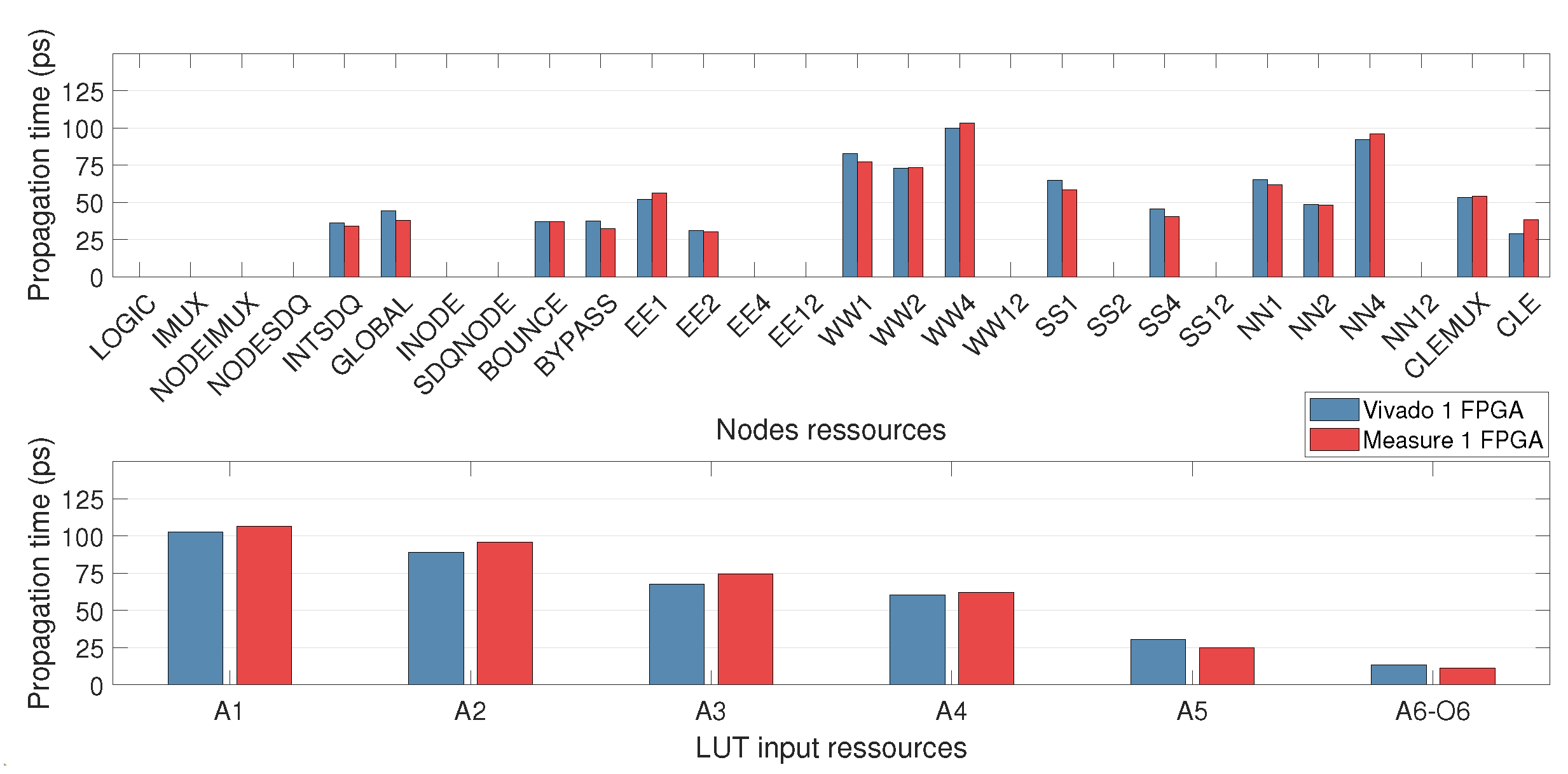

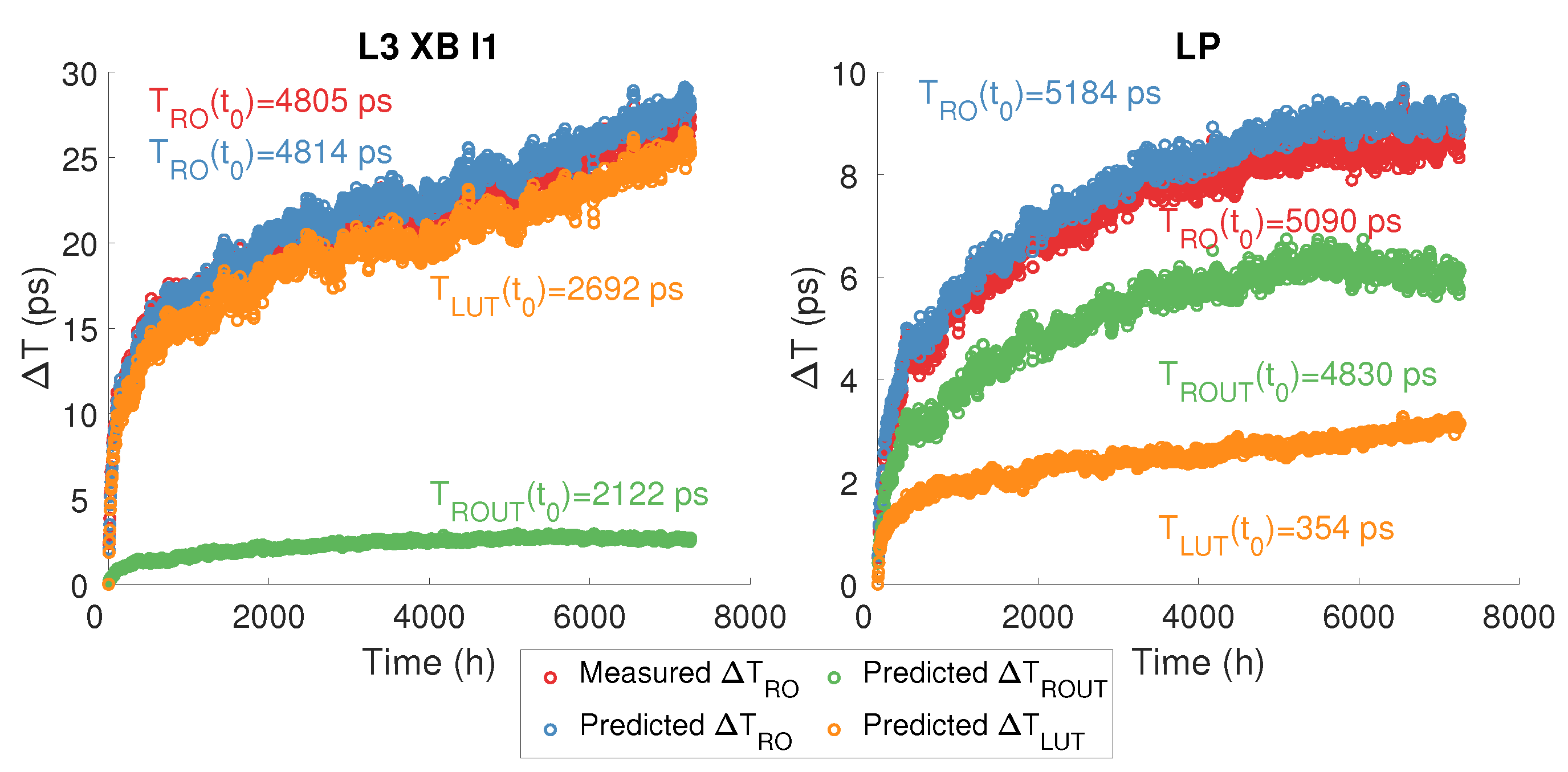
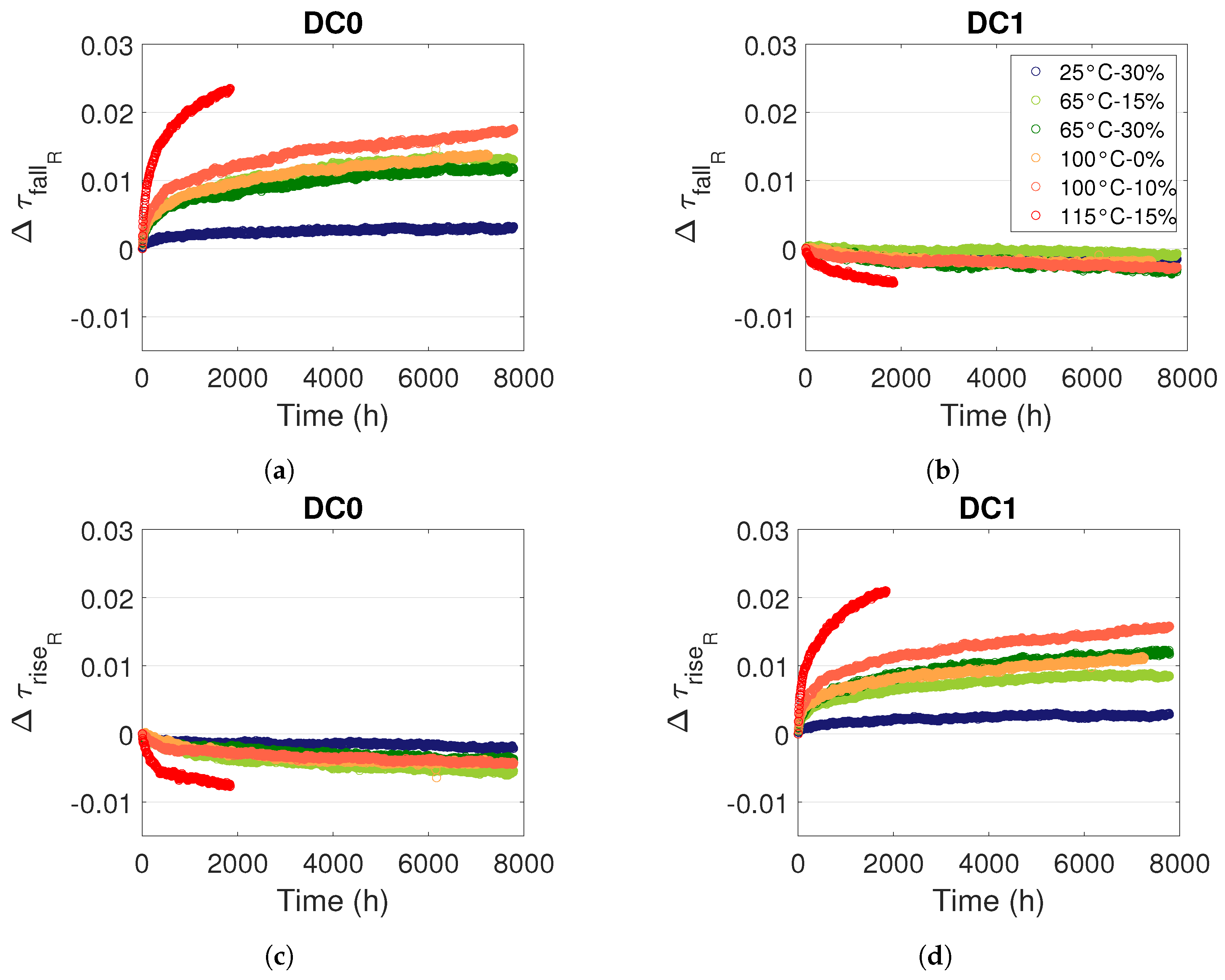





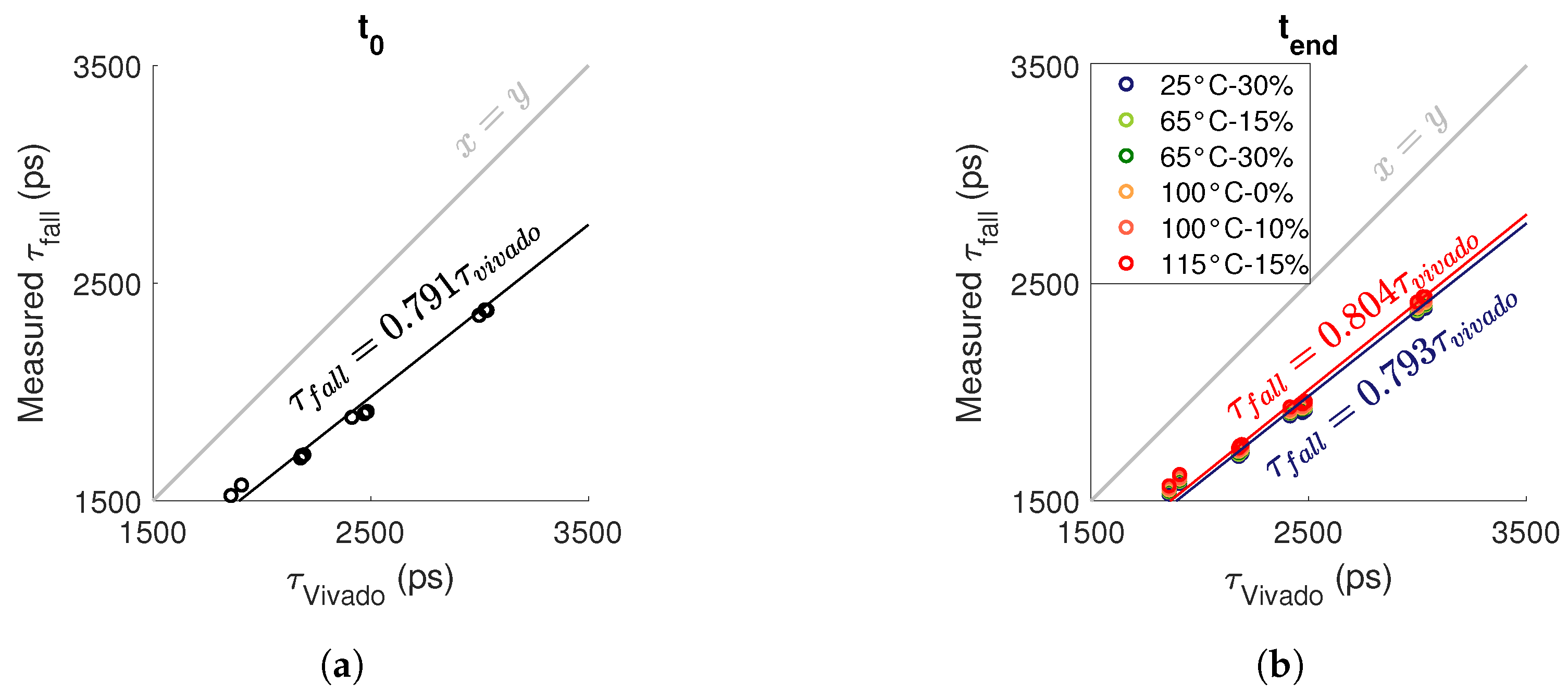
| FPGA | 1 | 2 | 3 | 4 | 5 | 6 | 7 | 8 | 9 |
|---|---|---|---|---|---|---|---|---|---|
| T (°C) | 25 | 25 | 25 | 65 | 65 | 100 | 100 | 100 | 115 |
| 1 | 1.15 | 1.3 | 1.15 | 1.3 | 1 | 1.1 | 1.2 | 1.15 |
| Zynq UltraScale+ 16 nm FinFET | Artix 28 nm HKMG | |||
|---|---|---|---|---|
| DC0 () | DC1 () | DC0 | DC1 | |
| A () | −21.3 | −15.3 | −0.592 | −0.066 |
| b | 0.251 | 0.240 | 0.262 | 0.265 |
| (eV) | 0.275 | 0.268 | 0.089 | 0.160 |
| () | 2.957 | 3.156 | 1.231 | 4.804 |
| , 25 °C) | ||||
| () | ||||
| , 115 °C) | ||||
| () | ||||
| A1 | 104 ps | stage 1: A1–A2 | 13 ps |
| A2 | 91 ps | stage 2: A2–A3 | 22 ps |
| A3 | 69 ps | stage 3: A3–A4 | 7 ps |
| A4 | 62 ps | stage 4: A4–A5 | 31 ps |
| A5 | 31 ps | stage 5: A5–A6 | 17 ps |
| A6 | 14 ps | stage 6: A6 | 14 ps |
| Degradation | Improvement | |||||
|---|---|---|---|---|---|---|
| (V−1) | (eV) | (V−1) | (eV) | |||
| LUT | ||||||
| ROUT | ||||||
Disclaimer/Publisher’s Note: The statements, opinions and data contained in all publications are solely those of the individual author(s) and contributor(s) and not of MDPI and/or the editor(s). MDPI and/or the editor(s) disclaim responsibility for any injury to people or property resulting from any ideas, methods, instructions or products referred to in the content. |
© 2023 by the authors. Licensee MDPI, Basel, Switzerland. This article is an open access article distributed under the terms and conditions of the Creative Commons Attribution (CC BY) license (https://creativecommons.org/licenses/by/4.0/).
Share and Cite
Sobas, J.; Marc, F. Degradation Measurement and Modelling under Ageing in a 16 nm FinFET FPGA. Micromachines 2024, 15, 19. https://doi.org/10.3390/mi15010019
Sobas J, Marc F. Degradation Measurement and Modelling under Ageing in a 16 nm FinFET FPGA. Micromachines. 2024; 15(1):19. https://doi.org/10.3390/mi15010019
Chicago/Turabian StyleSobas, Justin, and François Marc. 2024. "Degradation Measurement and Modelling under Ageing in a 16 nm FinFET FPGA" Micromachines 15, no. 1: 19. https://doi.org/10.3390/mi15010019
APA StyleSobas, J., & Marc, F. (2024). Degradation Measurement and Modelling under Ageing in a 16 nm FinFET FPGA. Micromachines, 15(1), 19. https://doi.org/10.3390/mi15010019






